Did you know that the ankle joint is one of the most complex in the body? This is mainly due to the many connections it has to other bones, tendons and ligaments. Because of this, what you may think is a simple ankle sprain may give you more pain than you ever imagined possible.
The main aspects of the ankle are the tibia and fibula which are the parallel bones of the lower leg. These two are held together by strong ligaments responsible for making them stay parallel to each other. The ligaments, therefore, are the ones responsible for stability. There are three lateral ligaments – anterior talofibular ligament, posterior talofibular ligament, and calcaneofibular ligament.
These ligaments are generally strong, but that does not mean they are not susceptible to injuries. The most commonly injured ligament is the anterior talofibular ligament or ATFL. If the ligament is mildly injured with no visible signs of damage on x-rays or scans and the pain is located higher up, it is referred to as a high ankle sprain.
People, in general, take sprains lightly because it is a condition where there is no actual fracture or severe damage. Nonetheless, this condition can very well lead to a bigger problem if left untreated. This is the exact reason why physicians would never tell you to ignore a foot or ankle sprain. They are not to be taken lightly and must be evaluated right away.
Common Foot and Ankle Injuries
Just to give you an idea of what conditions should be treated with foot and ankle braces, we are giving you the most common foot and ankle injuries, the first-aid treatments, and how braces can be of great help:
Ankle sprains and strains
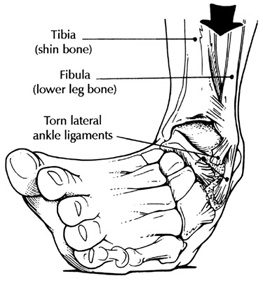
Sprains are injuries to the ligament while a strain is an injury to the muscle or tendon. Sprains are usually caused by direct or indirect trauma. Strains are more due to the overuse of the muscles and worn out tendons which are the result of injury from overstretching, direct blows, or excessive muscle contraction.
First aid for ankle sprains is PRICE – protect, rest, ice, compression, and elevation. With ankle sprains, your foot and ankle will be unable to detect ground details because of the injury. This is the main reason why some sports players try to run or shake this off since they really do not feel anything and later on end up injuring it even further.
Ankle sprains are thoroughly helped by foot and ankle braces and supports, as movement is allowed but kept to a minimum to pave the way for the healing process. It provides the support needed to still get around without injuring the foot or ankle even further.
The best type of foot and ankle brace for ankle sprains is thought to be lace-up supports because they are fully adjustable and give the best comfort.
Footballer’s ankle
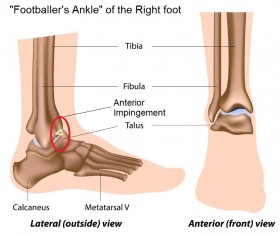
This is a foot injury common among football or soccer players – hence the name. It is basically a condition where the foot becomes unstable as a result of the repetitive abuse from kicking, tackling, toe pointing, pushing off, and jumping.
What happens to the ankle here is that the body stabilizes the unstable ankle by depositing calcium deposits to limit range of motion. If left untreated, this could lead to permanent loss of range of motion.
This is why as soon as something else seems amiss with the foot and ankle, it should be evaluated and your physician can tell you which foot and ankle brace would be right for you to prevent the calcium deposits and possibly loss of range of motion.
Achilles tendon rupture
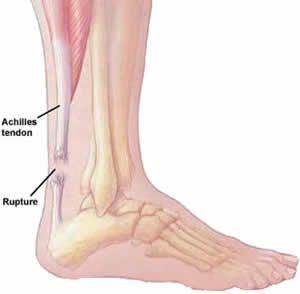
This is one of the more serious foot and ankle conditions that all athletes or active persons above the age of 30 dread. What everyone must remember here is that a perfectly normal tendon would not rupture and that only an already disintegrating and degenerating tendon is bound to rupture.
Treatment is through surgery and is a long and painful process. Those with mild cases do try foot and ankle braces first and hope to see some improvement after a while with proper therapy. But those with severe cases have no choice but to undergo surgery and only then wear braces and supports as the wounds inside and outside heal.
Stress fractures
This is a tricky one since it does not show up on x-rays. However, these have been deemed to have decreased in number today because of the improved shoe designs, and the foot and ankle supports that those who play sports now frequently wear as precautionary steps.
Foot drop
This is a permanent disorder that is either anatomical or muscular in origin where a person experiences difficulty lifting the foot from the ankle joint. As a result, most patients who suffer from this drag their foot when walking.
A brace is the number one treatment for foot drops, and it is divided into five categories:
- Short leg foot brace – This type is beneficial to those with flat foot and short height. However, it must be understood that this can only assist in walking and does not support a normal walk.
- Dorsiflexion assist foot brace – The ankle is thoroughly supported by a spring action to help lift the foot easier when walking. However, this is only recommended for patients below 225 lbs.
- Plantarflexion assist foot brace – This is best for those with severe drop foot. This tends to be on the heavy side but helps control the foot in the forward direction.
- Solid foot brace – This is another one suitable for severe cases of foot drop where both dorsal and plantar flexion capabilities are limited.
- Posterior leaf foot brace – This is the traditional foot brace that can be used for knee protection as well but is no longer being recommended today.
Different Types of Foot and Ankle Braces
Given that we rely solely on our feet in order to walk properly, any pain associated with the foot and/or ankle can be truly bothersome that it can hinder the activities of daily living.
Foot and ankle braces are not created or designed to make every inch of pain magically go away or make you walk normally again. They are functional medical devices that assist in the rehabilitation process of most of the foot and ankle injuries and conditions that we have mentioned above.
Traditional Ankle Braces
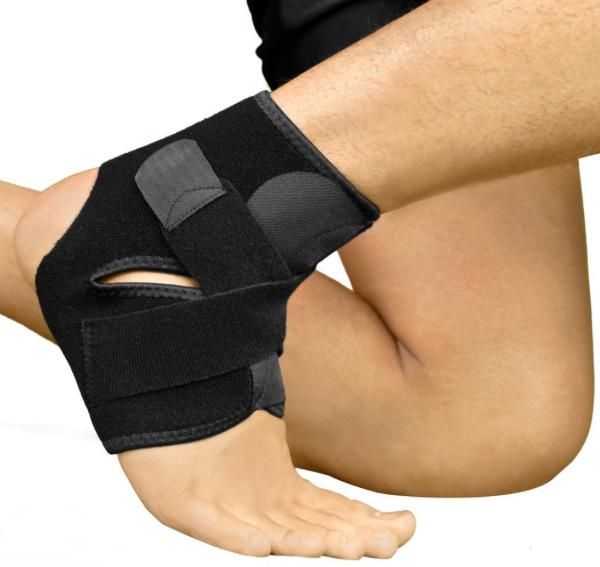
Bracoo Breathable Neoprene Ankle Support
These provide the perfect combination of compression and support that pave the way for ultimate healing. It increases the feeling of stability. However, you should go look for ones that have adjustable compression. Remember that you are going to use the braces to reduce swelling and inflammation and not make them worse.
Traditional ankle braces are divided into three categories:
- Rigid ankle braces – These offer the highest level of preventative and post-injury support yet allow the ankle to move and even maintain a full range of motion.
- Lace-Up braces – These are the most affordable type of ankle brace that offer preventative support yet comfort and freedom of movement.
- Soft ankle braces – This type is designed to conform to the shape of the ankle similar to what taping would usually do but without the hassle of tapes.
Ankle Sleeves
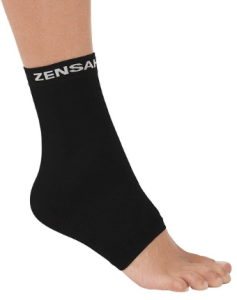
These also provide compression but do not offer a thorough support like a traditional ankle brace. This works best for swollen ankles, weak ankles, soft tissue injuries, and sprains. They basically help control possible over-rotation and over-movement of the ankle which could possibly cause further injuries.
Most ankle sleeves are made up of elastic and comfortable materials such as neoprene and canvas. Some come with padding and zippers while others do not.
Drop Foot Braces
Most drop foot braces in the market today has the latest technologies where there is a specific one for varying degrees of drop foot. If you are looking for a drop foot brace, make sure to pick one that is strong but lightweight and offers superb support.
Traction Boot
Specifically used by patients who need some form of traction in order for the leg, foot, or ankle to fully heal, a good traction boot must comfortably cradle the lower leg with an adjustable fit for absolute comfort.
Traction boots are also used to prevent skin ulcers for those with history of pressure ulcers in the past.
Night Splints
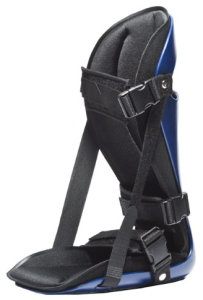
Getting a good night’s sleep when recovering from a painful injury is not exactly exciting. What used to be a sound sleep suddenly turns into a nighttime dilemma with a painful foot and/or ankle. And if you do get to sleep, waking up with a stiff foot is also not ideal.
Night splints alleviate all the symptoms that you would otherwise have with a painful foot and/or ankle recovering from an injury or surgery. It gives a slight, constant stretch throughout the night which effectively prevents stiffness and further aids in recovery.
Post-op Shoes
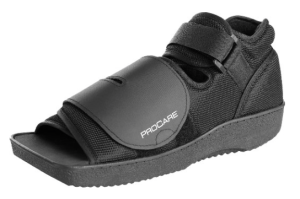
If you had a severe foot/ankle trauma or injury and needed surgery, you might be advised to use post-op shoes to aid in recovery and make things easier and less painful. It also prevents the formation of foot ulcers which would make this perfect for those with less than ideal blood sugar levels.
Post-op shoes basically provide added support and protection for forefoot and mid-foot sprains, fractures, and post-op foot and/or ankle surgeries.
Foot and ankle braces and support have always been greatly beneficial whether you are trying to protect your precious feet from injury or you are trying to recover from an injury. Just remember that each type of these medical braces functions differently which is why you should always seek the help of a medical professional.
Another thing to keep in mind as well is the fact that braces and/or supports do not cure an injury but offer adequate support to address pain and any discomfort a patient might be experiencing.
